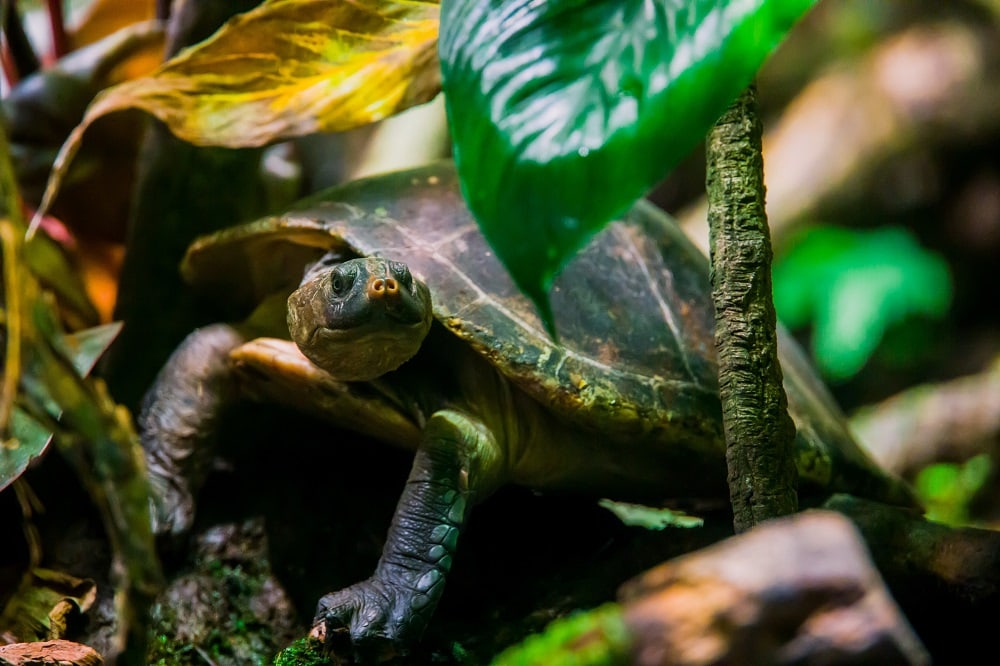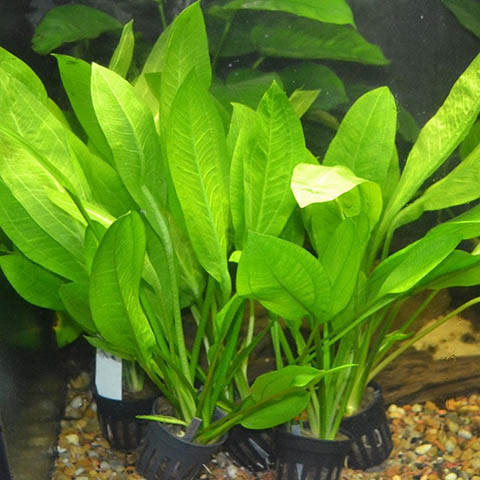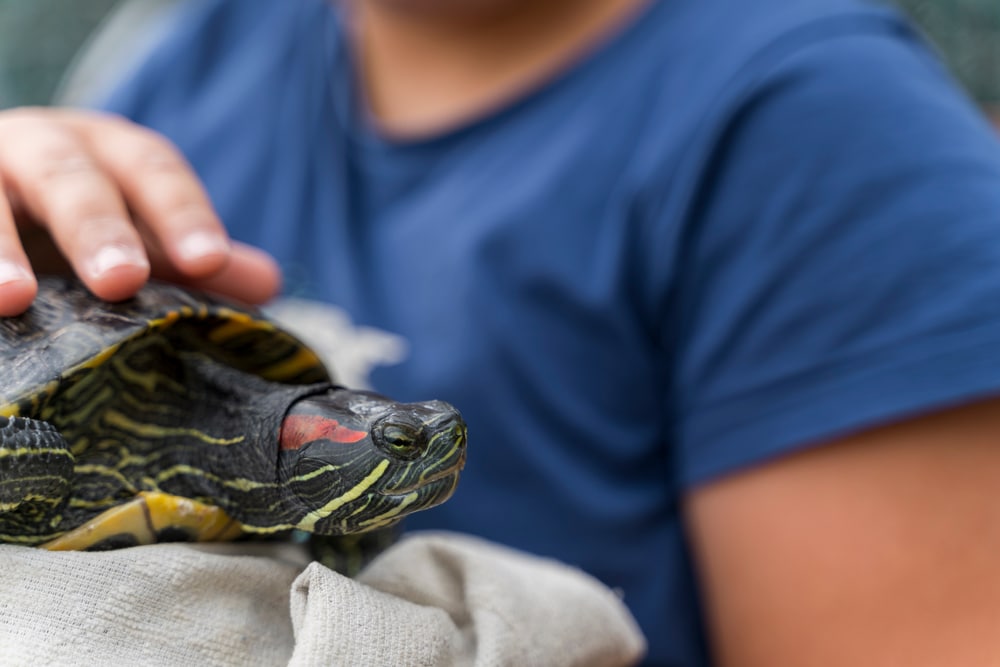
As a turtle owner, you already know they need a tank of 30 gallons or more of fresh, clean water, a dry place to rest, and plenty of UVA and UVB light. However, you might not know that your turtle needs to get at least half of its food from leafy green plants. Plants also do more than provide food for your turtle. They play a crucial role in keeping your tank clean and your turtle happy.
There are many aquatic plants you can put in your turtle’s tank. Selecting the best options for your pet can be time-consuming and difficult. That is why we have put together this helpful guide with reviews of the best plants for your turtle tank. After reading these reviews, you will know which plants can best meet your turtle’s needs.
 A Glance at Our Top Picks (2024 Update)
A Glance at Our Top Picks (2024 Update)
| Image | Product | Details | ||
|---|---|---|---|---|
| Best Overall |

|
Java Moss |
|
Check Price |
| Best Value Tank Cleaner |

|
Hornwort |
|
Check Price |
| Best Tank Beautifier |

|
African Water Fern |
|
Check Price |

|
Water Lettuce |
|
Check Price | |

|
Anacharis |
|
Check Price |
The 10 Best Plants for a Turtle Tank
1. Java Moss – Best Overall
Java moss is a widely available and affordable plant that serves multiple purposes in your turtle’s tank. This little plant can do it all. Java moss requires very little light and can attach itself to rocks or other hard surfaces. Turtles like to eat it, so it’s a useful food source. Java moss also helps clean your tank’s water. Finally, it gives the aquarium a natural, pond-like look, which your turtle will appreciate.
2. Hornwort – Best Value Tank Cleaner
Hornwort is a popular plant for turtles and is very fast growing. It can either float or be anchored to the bottom of your tank. One reason hornwort is so popular is that it is very easy to care for. Other than a plant light in your tank, you do not need to do much else to care for it. It also does a great job of filtering the water in your turtle’s tank. However, it’s not a favorite for turtles to munch on.
3. African Water Fern – Best Tank Beautifier
African water ferns are dark green with scalloped or forked leaves. They require little light and can grow up to 22 inches in length. The African water fern is very slow-growing. It can attach to any hard surface in your tank. They benefit from your turtle’s waste and can live for a very long time without much effort on your part. Turtles do not usually like to eat these leaves, so you don’t have to worry about the slow growth.
4. Water Lettuce
Water lettuce needs a high level of light to grow. However, it can be very beneficial to your tank. The plants have dangling roots that help filter your water and keep it clean. Turtles also like to shelter under the roots. Water lettuce is a tasty snack for turtles as the leaves are nice and crispy.
5. Anacharis
Anacharis is very easy to grow and maintain. Turtles also love to eat it so it is an excellent food source. The other name for Anacharis is waterweed—because it grows very quickly. It needs a moderate amount of light and can be left floating in the tank or anchored to the bottom. It’s a toss-up as to whether your turtles will gnaw on this plant.
6. Anubias
If you are looking for a slow-growing plant to put in your turtle’s tank, Anubias is a good choice. These plants have broad leaves that can grow up to 12 inches and are nearly impossible to kill. They don’t need a lot of light and can attach themselves to any surface in your tank. Anubias does have a very bitter taste, though, so your turtles will not eat it.
7. Java Fern
The Java fern is another plant that requires little care. They can thrive in low light and will grow up to 12 inches. Java ferns can either be partially or fully submerged in water. Turtles generally don’t eat these plants, but if a turtle does take a bite, the Java fern is non-toxic. They grow at a moderate pace and can live for a very long time with little work on your part.
8. Amazon Sword Plant
The Amazon sword plant needs a lot of light to thrive. However, as long as it has a good light source, this plant is quite easy to care for. It can grow quite large and needs to be firmly rooted in the tank with rocks or gravel. Turtles don’t usually eat these plants, so they are most useful as a filter for the water.
9. Moneywort
This bright green plant grows in long, straight shoots. It is quite attractive and a good way to beautify your tank. Moneywort will grow very quickly in moderate light, so be prepared to prune it if necessary. Luckily, turtles also like the taste of moneywort and will happily snack on it. This can help keep the growth in check. It is advisable to only have a few of these plants in your tank so that they don’t take over.
10. Duckweed
This is the fastest-growing plant on our list. Just a few of these small plants floating in your tank can multiply and cover the entire surface within days. Turtles love to snack on duckweed, which is great because it contains many nutrients. Duckweed also does a nice job of filtering your tank water. However, once you have duckweed in your tank, it is nearly impossible to get rid of. Because of this, you should only add it if you plan to keep it in check and frequently remove the excess so that it does not get out of control.
Buyer’s Guide: Choosing the Best Plants for a Turtle Tank
Navigating the market of live plants for your turtle tank can be murky, but using this guide should make it easier. As a turtle owner, you know the basic materials you need to keep your turtle happy and healthy. Now you also know which plants are the best buys for your aquarium. But do you know why you need a variety of plants for your turtles?
The Role of Live Plants in Your Turtle’s Tank
Live plants are critical to the health of your turtle and its environment. Not only do they beautify the tank, but they also make it more like the turtle’s natural habitat. Live plants also give your turtle a safe place to hide or seek cover.
Another role played by live plants in your turtle’s tank is a food source. While turtles won’t eat all types of plants, there are several that they do like to snack on. Since the majority of a turtle’s diet should come from plants, especially as they get older, having live plants around for snacking is a great way to meet their nutritional needs.
Finally, live plants help keep your tank clean. Since your turtle spends most of its time in the water, they need it to be clean. You should change out the water frequently. Plants can help keep the water clean between changes. Live plants are excellent filters of harmful waste such as nitrates and ammonia. They can also help reduce or slow the growth of algae in your tank.
Buying Plants
You want to make sure you get a good combination of live plants that will meet your turtle’s needs without taking over. Our list above ranks the best plants based on ease of care, usefulness in your tank, and benefits to your turtle. The biggest issue with the plants near the bottom of our list was the potential for overgrowth. While duckweed and moneywort are good for your turtle, they require work on your part, otherwise, they will take over your tank.
The key is to find balance. Perhaps consider a plant or two that your turtle will snack on, and another that provides shelter or a hiding place. Most of the plants on this list are affordable and easy to care for. You should just make sure that you are buying plants that can thrive in the environment you have with the level of attention you are willing to give them.

Plants to Avoid
While turtles can coexist happily with many aquatic plants, there are some you should never put in your turtle’s tank. These include the following:
Also, while turtles enjoy some fruits and vegetables as snacks, they should never be fed avocados, onions, or potatoes. Turtles should never be fed seeds because they are unable to digest them.
Conclusion
There are many plants you can put in your turtle’s tank. Based on our reviews, the best choices are Java moss and hornwort. Java moss does it all—it is a great food source, keeps your tank clean, and requires little care. While turtles do not eat hornwort, it is one of the best values for easy tank filtration.
Now that you have read our guide, you should feel confident that you can find the best plants for your turtle tank!
Featured Image Credit: Brendan Beale, unsplash



















